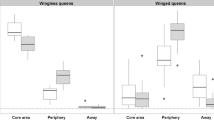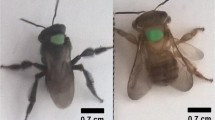Abstract
While reproduction and longevity are negatively correlated in a large number of animals, this fundamental trade-off appears to be absent from social insect queens. Here, we examine the distribution of the life-spans of queens and their mates and the age-trajectory of reproduction in experimental colonies of the Pacific tramp ant Cardiocondyla cf. kagutsuchi. Queens of Cardiocondyla are generally short-lived (0.5–2 years), which allows determining their lifetime reproductive success and establishing mortality tables. We show that the queen’s total number of sexual offspring is positively associated with its life-span. Regular counts of eggs, larvae, and pupae suggest that more fecund queens live longer than less fecund queens and that an early onset of sexual production does not negatively affect the queen’s life-span. This corroborates the view that the costs of reproduction are not born by the queen itself. The number of eggs present in colonies increased with queen’s age until shortly before death, indicating negligible reproductive senescence. Sex ratios were strongly affected by the origin of queens but neither by colony size nor total productivity. Several queens produced only males late in their lives, suggesting the occurrence of sperm depletion. Male life-span was not correlated with any other studied trait. Our study shows that the ant genus Cardiocondyla provides a suitable model system to investigate the evolution of life-span in social insect queens and males.




Similar content being viewed by others
References
Akman Gündüz E, Gülel A (2005) Investigation of fecundity and sex ratio in the parasitoid Bracon hebetor Say (Hymenoptera: Braconidae) in relation to parasitoid age. Turk J Zool 29:291–294
Bosch J, Vicens N (2006) Relationship between body size, provisioning rate, longevity and reproductive success in females of the solitary bee Osmia cornuta. Behav Ecol Sociobiol 60:26–33
Bourke AFG (1999) Colony size, social complexity and reproductive conflict in social insects. J Evol Biol 12:245–257
Bourke AFG (2007) Kin selection and the evolutionary theory of aging. Annu Rev Ecol Evol Syst 38:103–128
Carey JR (2001) Insect biodemography. Annu Rev Entomol 46:79–110
Cole BJ (2009) The ecological setting of social evolution: the demography of ant populations. In: Gadau J, Fewell J (eds) Organization of insect societies. Harvard University Press, Cambridge, pp 74–104
Corona M, Velarde RA, Remolina S, Moran-Lauter A, Wang Y, Hughes KA, Robinson GE (2007) Vitellogenin, juvenile hormone, insulin signaling, and queen honey bee longevity. Proc Natl Acad Sci USA 104:7128–7133
Cremer S, Heinze J (2002) Adaptive production of fighter males: queens of the ant Cardiocondyla adjust the sex ratio under local mate competition. Proc R Soc Lond B 269:417–422
Dixon AFG, Agarwala BK (2002) Triangular fecundity function and ageing in ladybird beetles. Ecol Entomol 27:473–440
Dytham C, Travis JMJ (2006) Evolving dispersal and age at death. Oikos 113:530–538
Finch CE (1998) Variations in senescence and longevity include the possibility of negligible senescence. J Gerontol A Biol Sci Med Sci 53A:B235–B239
Frohschammer S, Heinze J (2009) A heritable component in sex ratio and caste determination in a Cardiocondyla ant. Front Zool 6:27
Hartmann A, Heinze J (2003) Lay eggs, live longer: division of labor and life span in a clonal ant species. Evolution 57:2424–2429
Heinze J, Delabie JHC (2005) Population structure of the male-polymorphic ant Cardiocondyla obscurior. Stud Neotropical Fauna Environ 40:187–190
Heinze J, Schrempf A (2008) Aging and reproduction in social insects. Gerontology 54:160–167
Heinze J, Schrempf A (2012) Terminal investment: individual reproduction of ant queens increases with age. PLoS One 7:e35201
Holm S (1979) A simple sequential rejective multiple test procedure. Scand J Stat 6:65–70
Jemielity S, Chapuisat M, Parked JD, Keller L (2005) Long live the queen: studying aging in social insects. Age 27:241–248
Keller L (1998) Queen lifespan and colony characteristics in ants and termites. Insectes Soc 45:235–246
Keller L, Genoud M (1997) Extraordinary lifespans in ants: a test of evolutionary theories of ageing. Nature 389:958–960
Khazaeli AA, Van Voorhies W, Curtsinger JW (2005) The relationship between life span and adult body size is highly strain-specific in Drosophila melanogaster. Exp Gerontol 40:377–385
Lenoir J-C, Schrempf A, Lenoir A, Heinze J, Mercier J-L (2007) Genetic structure and reproductive strategy of the ant Cardiocondyla elegans: strictly monogynous nests invaded by unrelated sexuals. Mol Ecol 16:345–354
Lopez-Vaamonde C, Raine NE, Koning JW, Brown RM, Pereboom JJM, Ings TC, Ramos-Rodriguez O, Jordan WC, Bourke AFG (2009) Lifetime reproductive success and longevity of queens in an annual social insect. J Evol Biol 22:983–996
Markov AV (2012) Can kin selection facilitate the evolution of the genetic program of senescence? Biochem (Moscow) 77:733–741
Mitteldorf J (2006) Chaotic population dynamics and the evolution of ageing. Evol Ecol Res 8:561–574
Müller CB, Schmid-Hempel P (1992) Correlates of reproductive success among field colonies of Bombus lucorum: the importance of growth and parasites. Ecol Entomol 17:343–353
Münch D, Amdam GV, Wolschin F (2008) Ageing in a eusocial insect: molecular and physiological characteristics of life span plasticity in the honey bee. Funct Ecol 22:407–421
Novoseltsev VN, Arking R, Carey JR, Novoseltseva JA, Yashin AT (2005) Individual fecundity and senescence in Drosophila and medfly. J Gerontol A 60:953–962
Oettler J, Suefuji M, Heinze J (2010) The evolution of alternative reproductive tactics in male Cardiocondyla ants. Evolution 64:3310–3317
Page RE Jr, Peng CYS (2001) Aging and development in social insects with emphasis on the honeybee, Apis mellifera L. Exp Gerontol 36:695–711
Parker JD (2010) What are social insects telling us about aging? Myrm News 13:103–110
Remolina SC, Hughes KA (2008) Evolution and mechanisms of long life and high fertility in queen honey bees. Age 30:177–185
Reznick D, Nunney L, Tessier A (2000) Big houses, big cars, superfleas and the costs of reproduction. Trends Ecol Evol 15:421–425
Ronce O, Promislow D (2010) Kin competition, natal dispersal and the moulding of senescence by natural selection. Proc R Soc Lond B 277:3659–3667
Rueppell O (2009) Aging of social insects. In: Gadau J, Fewell J (eds) Organization of insect societies. Harvard University Press, Cambridge, pp 51–73
Rueppell O, Fondrk MK, Page RE Jr (2005) Biodemographic analysis of male honey bee mortality. Aging Cell 4:13–19
Schrempf A, Heinze J (2007) Back to one: consequences of derived monogyny in an ant with polygynous ancestors. J Evol Biol 20:792–799
Schrempf A, Heinze J, Cremer S (2005a) Sexual cooperation: mating increases longevity in ant queens. Curr Biol 15:267–270
Schrempf A, Reber C, Tinaut A, Heinze J (2005b) Inbreeding and local mate competition in the ant Cardiocondyla batesii. Behav Ecol Sociobiol 57:502–510
Schrempf A, Aron S, Heinze J (2006) Sex determination and inbreeding depression in an ant with regular sib-mating. Heredity 97:75–80
Schrempf A, Darrouzet E, Heinze J (2007) Mating success and potential male-worker conflict in a male-dimorphic ant. BMC Evol Biol 7:114
Schrempf A, Cremer S, Heinze J (2011) Social influence on age and reproduction: reduced lifespan and fecundity in multi-queen ant colonies. J Evol Biol 24:1455–1461
Seifert B (2003) The ant genus Cardiocondyla (Insecta: Hymenoptera: Formicidae) a taxonomic revision of the C. elegans, C. bulgarica, C. batesii, C. nuda, C. shuckardi, C. stambuloffi, C. wroughtonii, C. emeryi, and C. minutior species groups. Ann Naturhist Mus Wien 104:203–338
Shik JZ, Flatt D, Kay A, Kaspari M (2012) A life history continuum in the males of a Neotropical ant assemblage: refuting the sperm vessel hypothesis. Naturwissenschaften 99:191–197
Strohm E, Bordon-Hauser A (2003) Advantages and disadvantages of large colony size in the halictid bee: the queen’s perspective. Behav Ecol 14:546–553
Travis JMJ (2004) The evolution of programmed death in a spatially structured population. J Gerontol A Biol Sci Med Sci 59:301–305
Tschinkel WR (1991) Insect sociometry, a field in search of data. Insect Soc 38:77–82
Tsuji K, Nakata K, Heinze J (1996) Lifespan and reproduction in a queenless ant. Naturwissenschaften 83:577–578
Weber NA (1938) The biology of the fungus-growing ants. Part 4. Additional new forms. Part 5. The Attini of Bolivia. Rev Entomol 9:154–206
Yamauchi K, Asano Y, Lautenschläger B, Trindl A, Heinze J (2005) A new type of male dimorphism with ergatoid and short-winged males in Cardiocondyla cf. kagutsuchi. Insect Soc 52:274–281
Yamauchi K, Ishida Y, Hashim R, Heinze J (2006) Queen–queen competition by precocious male production in multiqueen ant colonies. Curr Biol 16:2424–2427
Zuur A, Ieno EN, Walker N, Saveliev AA, Smith GM (2009) Mixed effects models and extensions in ecology with R. Springer, Heidelberg
Acknowledgments
Studies on Hawaiian Cardiocondyla were made possible through export permits issued by the US Fish and Wildlife Service. M. Suefuji provided colonies from Okinawa. Two referees made helpful comments on the manuscript.
Author information
Authors and Affiliations
Corresponding author
Additional information
Communicated by O. Rueppell
Rights and permissions
About this article
Cite this article
Heinze, J., Frohschammer, S. & Bernadou, A. Queen life-span and total reproductive success are positively associated in the ant Cardiocondyla cf. kagutsuchi . Behav Ecol Sociobiol 67, 1555–1562 (2013). https://doi.org/10.1007/s00265-013-1567-9
Received:
Revised:
Accepted:
Published:
Issue Date:
DOI: https://doi.org/10.1007/s00265-013-1567-9




